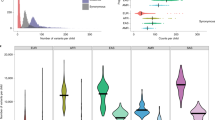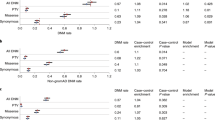Abstract
The per-generation mutation rate in humans is high. De novo mutations may compensate for allele loss due to severely reduced fecundity in common neurodevelopmental and psychiatric diseases, explaining a major paradox in evolutionary genetic theory. Here we used a family based exome sequencing approach to test this de novo mutation hypothesis in ten individuals with unexplained mental retardation. We identified and validated unique non-synonymous de novo mutations in nine genes. Six of these, identified in six different individuals, are likely to be pathogenic based on gene function, evolutionary conservation and mutation impact. Our findings provide strong experimental support for a de novo paradigm for mental retardation. Together with de novo copy number variation, de novo point mutations of large effect could explain the majority of all mental retardation cases in the population.
This is a preview of subscription content, access via your institution
Access options
Subscribe to this journal
Receive 12 print issues and online access
$209.00 per year
only $17.42 per issue
Buy this article
- Purchase on Springer Link
- Instant access to full article PDF
Prices may be subject to local taxes which are calculated during checkout

Similar content being viewed by others
Accession codes
Accessions
NCBI Reference Sequence
References
Roach, J.C. et al. Analysis of genetic inheritance in a family quartet by whole-genome sequencing. Science 328, 636–639 (2010).
Lynch, M. Rate, molecular spectrum, and consequences of human mutation. Proc. Natl. Acad. Sci. USA 107, 961–968 (2010).
Keller, M.C. & Miller, G. Resolving the paradox of common, harmful, heritable mental disorders: which evolutionary genetic models work best? Behav. Brain Sci. 29, 385–404 (2006).
Uher, R. The role of genetic variation in the causation of mental illness: an evolution-informed framework. Mol. Psychiatry 14, 1072–1082 (2009).
Cook, E.H. Jr. & Scherer, S.W. Copy-number variations associated with neuropsychiatric conditions. Nature 455, 919–923 (2008).
de Vries, B.B. et al. Diagnostic genome profiling in mental retardation. Am. J. Hum. Genet. 77, 606–616 (2005).
Ng, S.B. et al. Exome sequencing identifies the cause of a mendelian disorder. Nat. Genet. 42, 30–35 (2010).
Lupski, J.R. et al. Whole-genome sequencing in a patient with Charcot-Marie-Tooth neuropathy. N. Engl. J. Med. 362, 1181–1191 (2010).
Hoischen, A. et al. De novo mutations of SETBP1 cause Schinzel-Giedion syndrome. Nat. Genet. 42, 483–485 (2010).
Sobreira, N.L. et al. Whole-genome sequencing of a single proband together with linkage analysis identifies a Mendelian disease gene. PLoS Genet. 6, e1000991 (2010).
Tarpey, P.S. et al. A systematic, large-scale resequencing screen of X-chromosome coding exons in mental retardation. Nat. Genet. 41, 535–543 (2010).
Jensen, L.R. et al. Mutations in the JARID1C gene, which is involved in transcriptional regulation and chromatin remodeling, cause X-linked mental retardation. Am. J. Hum. Genet. 76, 227–236 (2005).
Mulero, J.J. et al. Three new human members of the lipid transfer/lipopolysaccharide binding protein family (LT/LBP). Immunogenetics 54, 293–300 (2002).
Taggart, R.T. et al. Relationships between the human pepsinogen DNA and protein polymorphisms. Am. J. Hum. Genet. 38, 848–854 (1986).
Giannandrea, M. et al. Mutations in the small GTPase gene RAB39B are responsible for X-linked mental retardation associated with autism, epilepsy, and macrocephaly. Am. J. Hum. Genet. 86, 185–195 (2010).
Hamdan, F.F. et al. Mutations in SYNGAP1 in autosomal nonsyndromic mental retardation. N. Engl. J. Med. 360, 599–605 (2009).
Chen, X.J. et al. Proprioceptive sensory neuropathy in mice with a mutation in the cytoplasmic Dynein heavy chain 1 gene. J. Neurosci. 27, 14515–14524 (2007).
Tsujikawa, M., Omori, Y., Biyanwila, J. & Malicki, J. Mechanism of positioning the cell nucleus in vertebrate photoreceptors. Proc. Natl. Acad. Sci. USA 104, 14819–14824 (2007).
Tai, C.Y., Dujardin, D.L., Faulkner, N.E. & Vallee, R.B. Role of dynein, dynactin, and CLIP-170 interactions in LIS1 kinetochore function. J. Cell Biol. 156, 959–968 (2002).
He, Y. & Casaccia-Bonnefil, P. The Yin and Yang of YY1 in the nervous system. J. Neurochem. 106, 1493–1502 (2008).
Forlani, G. et al. The MeCP2/YY1 interaction regulates ANT1 expression at 4q35: novel hints for Rett syndrome pathogenesis. Hum. Mol. Genet. 19, 3114–3123 (2010).
Veraksa, A., Kennison, J. & McGinnis, W. DEAF-1 function is essential for the early embryonic development of Drosophila. Genesis 33, 67–76 (2002).
Hahm, K. et al. Defective neural tube closure and anteroposterior patterning in mice lacking the LIM protein LMO4 or its interacting partner Deaf-1. Mol. Cell. Biol. 24, 2074–2082 (2004).
Lee, C.J. et al. CIC, a member of a novel subfamily of the HMG-box superfamily, is transiently expressed in developing granule neurons. Brain Res. Mol. Brain Res. 106, 151–156 (2002).
Whibley, A.C. et al. Fine-scale survey of X chromosome copy number variants and indels underlying intellectual disability. Am. J. Hum. Genet. 87, 173–188 (2010).
Marth, G.T. et al. A general approach to single-nucleotide polymorphism discovery. Nat. Genet. 23, 452–456 (1999).
Ng, S.B. et al. Targeted capture and massively parallel sequencing of 12 human exomes. Nature 461, 272–276 (2009).
Pushkarev, D., Neff, N.F. & Quake, S.R. Single-molecule sequencing of an individual human genome. Nat. Biotechnol. 27, 847–852 (2009).
Wang, J. et al. The diploid genome sequence of an Asian individual. Nature 456, 60–65 (2008).
Venables, W.N. & Ripley, B.D. Modern Applied Statistics with S (Springer, 4th edn., New York, New York, USA, 2002).
Lilliefors, H. On the Kolmogorov–Smirnov test for normality with mean and variance unknown. J. Am. Stat. Assoc. 62, 399–402 (1967).
Acknowledgements
We thank R. de Reuver and J. Hehir-Kwa for bioinformatics support in data analysis and personnel from the Sequencing Facility of our department for timely completion of Sanger sequencing of validation experiments. This work was funded in part by grants from The Netherlands Organization for Health Research and Development (ZonMW grants 916-86-016 to L.E.L.M.V., 917-66-36 and 911-08-025 to J.A.V. and 917-86-319 to B.B.A.d.V.), the EU-funded TECHGENE project (Health-F5-2009-223143 to J.d.L. and J.A.V.) and the AnEUploidy project (LSHG-CT-2006-37627 to A.H., B.W.M.v.B., H.G.B., B.B.A.d.V. and J.A.V.).
Author information
Authors and Affiliations
Contributions
J.A.V., L.E.L.M.V. and H.G.B. conceived the project and planned the experiments. B.B.A.d.V. and B.W.M.v.B. performed sample collection and reviewed phenotypes. L.E.L.M.V., A.H., I.J., M.S., P.d.V., B.v.L. and P.A. performed next-generation sequencing experiments using a custom pipeline set up by C.G. and A.H. J.d.L. and C.G. analyzed and interpreted the data with support from N.W. and M.d.R. L.E.L.M.V., P.d.V., I.J. and M.S. performed validation experiments. L.E.L.M.V., J.d.L. and J.A.V. prepared the first draft of the manuscript. All authors contributed to the final manuscript.
Corresponding authors
Ethics declarations
Competing interests
The authors declare no competing financial interests.
Supplementary information
Supplementary Text and Figures
Supplementary Note, Supplementary Tables 1 and 2 and Supplementary Figures 1–5 (PDF 1579 kb)
Rights and permissions
About this article
Cite this article
Vissers, L., de Ligt, J., Gilissen, C. et al. A de novo paradigm for mental retardation. Nat Genet 42, 1109–1112 (2010). https://doi.org/10.1038/ng.712
Received:
Accepted:
Published:
Issue Date:
DOI: https://doi.org/10.1038/ng.712
This article is cited by
-
Re-evaluation and re-analysis of 152 research exomes five years after the initial report reveals clinically relevant changes in 18%
European Journal of Human Genetics (2023)
-
Combining chromosomal microarray and clinical exome sequencing for genetic diagnosis of intellectual disability
Scientific Reports (2023)
-
Deciphering Intellectual Disability
Indian Journal of Pediatrics (2023)
-
De novo variants underlying monogenic syndromes with intellectual disability in a neurodevelopmental cohort from India
European Journal of Human Genetics (2023)
-
PhenoScore quantifies phenotypic variation for rare genetic diseases by combining facial analysis with other clinical features using a machine-learning framework
Nature Genetics (2023)



